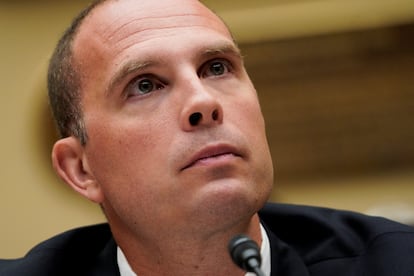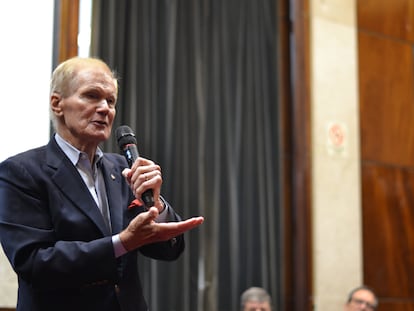Why does the United States never stop talking about UFOs?
Talk about aliens and unidentified flying objects — taboo for decades in Washington — recently became one of the hot topics on Capitol Hill, thanks to a group of congresspeople in search of answers


The long love affair between the United States and UFOs is experiencing a torrid second honeymoon. In 2020, the decision by the Department of Defense to release a series of videos from 2004 and 2015 — depicting encounters by military pilots with unidentified flying objects (UFOs) — sent the imagination of public opinion soaring. Now, this curiosity has moved a group of congresspeople in Washington to shake off long-standing taboos in search of answers about what the authorities prefer to call unidentified aerial phenomena (UAP) — a term used to brush away the tinge of conspiracy that the term “UFO” carries.
Spacecraft of extraterrestrial origin fit into the UAP category, certainly, but also — and above all — balloons (spy, weather, or other types), threats to national security in the form of supersonic devices from rival powers such as China and Russia, aerospace junk, Elon Musk’s satellites or, simply, the illusions created by certain optical effects.
UFOs landed in Congress this past week, in a hearing that was explosive, despite the fact that all their revelations were already known. Whistleblower David Grusch — who worked in the intelligence services for 14 years and testified under oath — spoke before Congress and insisted that the government has a damaged alien spacecraft in its possession, along with “non-human biological remains.” However, he clarified that he hadn’t seen any of this with his own eyes: he was allegedly told about the materials while conducting investigations for the Pentagon. He said that, over the course of four years, he interviewed 40 people on the subject.

68% of Americans are convinced that their government knows more about UFOs than it lets on, according to a 2019 poll by Gallup poll. Like Grusch, 33% believe that some sightings are related to alien spacecraft visiting the Earth. “My testimony is based on information I’ve been given by individuals with a long-standing track record of legitimacy and service to this country, many of whom have shared compelling evidence in the form of photography, official documentation and classified oral testimony [with] myself and many colleagues,” Grusch assured the House Oversight Committee. As this was all classified information, he didn’t provide further evidence. “Otherwise, I would go to jail,” he explained.
The Pentagon reacted to this testimony with a resounding denial, stating that its investigators had obtained “no verifiable information to corroborate these claims.” Skeptical voices were also heard on Wednesday, amid an unusual climate of bipartisan harmony. For instance, Eric Burlison, a Republican from Missouri, said it didn’t add up to him that “an alien species [that’s] technologically advanced enough to travel billions of light-years” would then be unable to survive on Earth and end up crashing their ship. “It seems crazy to me,” he said.
Grusch’s complaint — which incorporates some of the classic elements of UFO-based conspiracy theories — was actually published in a handful of marginal media outlets back in June, after newspapers such as The New York Times and The Washington Post decided not to publish his allegations. The two authors of the piece had previously written another article in 2017 in the New York newspaper, a milestone in the new golden age of American fascination with UFOs.
In their article, Grusch and his co-author revealed the existence of a Pentagon program that had been studying UAP military sightings since 2007. It has an endowment (buried deep in the U.S. defense budget) and was launched by Nevada Senator Harry Reid, who died in 2022. Nevada is home to the secret military base known as Area 51, a mecca for lovers of alien conspiracy theories. Many believe that this site is where the military keeps the biological remains of aliens.
Jimmy Carter and Venus
Senator Reid — a Democrat who was the senate majority leader from 2007 until 2015 — belonged to a long line of U.S. politicians who have been curious about UFOs. The list includes such illustrious names as Hillary Clinton, who, when she was a presidential candidate in 2016, responded to a question about UAPs: “There are enough stories out there” to not believe that “people are just making them up sitting in their kitchens at home.” Jimmy Carter is also on the list: the former president saw a UFO in 1969, but didn’t dare report it until four years later, to the International UFO Bureau in Oklahoma. That body concluded that what the future president had witnessed was actually Venus doing her thing.
Kentucky Republican Glenn Grothman — leader of the Subcommittee on National Security, the Border, and Foreign Affairs, which organized Wednesday’s congressional hearing — recalled Carter in his speech. He also cited another White House tenant, Gerald Ford, but in this case, he was off. Ford’s history with UFOs is limited to a petition he made in 1966, when he was a congressman, according to documents from his presidential library that can be consulted online. He asked that recently reported UFO sightings in his home state of Michigan be investigated.
At that time, the fascination with UFOs was in robust health in the United States. The newly unleashed mass culture enthusiastically embraced the first “UFO incident” of the modern era, recorded a couple of decades earlier, on June 24, 1947. Then, a pilot named Kenneth Arnold described a string of nine glowing unidentified objects. They flew over Mount Rainier, south of Seattle, at enormous speed.
Arnold’s description introduced the expression “flying saucer” into popular parlance and sparked a veritable fever, with hundreds of similar sightings reported in the following weeks. The Air Force studied more than 12,000 sightings before cancelling the Project Blue Book program in 1969. Most were attributed to stars, clouds, commercial jets or spy planes, although 701 remained unexplained. Back then — just as today — astrophysicists reminded the public not to forget that even if there’s no plausible justification for a flying object, it doesn’t necessarily make the extraterrestrial hypothesis the most probable.
What happened after Arnold’s experience contains the big problem (and the golden rule) of UFOs: the more you look for them, the more you find. Especially in times like ours, with the skies populated by drones and other gadgets, when everyone is carrying a camera on their smartphone. In a hearing before the U.S. Senate’s Armed Services subcommittee, Sean Kirkpatrick — director of the wonderfully named All-domain Anomaly Resolution Office (AARO) — confirmed this theory in April. Between 2004 and June 2021, 144 UFO incidents were reported. At the beginning of this year, there were already 350. Four months later, that number had risen to 650. By this point in July, it already exceeds 800, of which it is estimated that only between 2% and 5% merit attention.
The February incident of the Chinese balloon crossing the United States before being shot down over the Atlantic had to do with this boom. It left behind — in addition to escalated diplomatic tensions between the two countries — a trail of sightings of suspicious objects. After that occurrence, America’s defense agencies recalibrated their airspace surveillance systems, so they could detect smaller, slow-moving objects that wouldn’t have counted as threats before.
The Chinese balloon was cited repeatedly at Wednesday’s hearing, at which two retired military pilots, Ryan Graves and David Fravor, also testified. Both men recounted two separate encounters with UFOs (seen in videos that the Pentagon released three years ago) in light of the fact that they had been circulating on the internet for a long time. It was those recordings that pushed lawmakers to demand greater transparency from the Pentagon and hold a congressional hearing in May of last year (the first on the subject in half-a-century).
In the Capitol, the legislators don’t seem willing to drop the issue, which has lost much of the stigma that it once carried. Chuck Schumer, the Democratic majority leader in the Senate, has introduced a bill to create a new commission, which will have the authority to declassify documents on UFOs and extraterrestrial affairs. Meanwhile, Bill Nelson — the director of NASA who, in 1986, became the first member of the House to travel into space — confirmed to El PAÍS that he had commissioned a report from “a committee of very distinguished scientists,” given the renewed interest in the matter. He promised that the report would be published in August.
Sign up for our weekly newsletter to get more English-language news coverage from EL PAÍS USA Edition
Tu suscripción se está usando en otro dispositivo
¿Quieres añadir otro usuario a tu suscripción?
Si continúas leyendo en este dispositivo, no se podrá leer en el otro.
FlechaTu suscripción se está usando en otro dispositivo y solo puedes acceder a EL PAÍS desde un dispositivo a la vez.
Si quieres compartir tu cuenta, cambia tu suscripción a la modalidad Premium, así podrás añadir otro usuario. Cada uno accederá con su propia cuenta de email, lo que os permitirá personalizar vuestra experiencia en EL PAÍS.
¿Tienes una suscripción de empresa? Accede aquí para contratar más cuentas.
En el caso de no saber quién está usando tu cuenta, te recomendamos cambiar tu contraseña aquí.
Si decides continuar compartiendo tu cuenta, este mensaje se mostrará en tu dispositivo y en el de la otra persona que está usando tu cuenta de forma indefinida, afectando a tu experiencia de lectura. Puedes consultar aquí los términos y condiciones de la suscripción digital.
More information
Archived In
Últimas noticias
Aquilino Gonell, former Capitol sergeant: ‘If it hadn’t been for the police, the US would be a dictatorship’
A hybrid building: Soccer pitch, housing, and a shopping mall
Europe urges Trump to respect Greenland following annexation threats
Science seeks keys to human longevity in the genetic mixing of Brazilian supercentenarians
Most viewed
- Alain Aspect, Nobel laureate in physics: ‘Einstein was so smart that he would have had to recognize quantum entanglement’
- Mexico’s missing people crisis casts a shadow over World Cup venue
- Alvin Hellerstein, a 92-year-old judge appointed by Bill Clinton, to preside over Maduro’s trial in New York
- Why oil has been at the center of Venezuela-US conflicts for decades
- Cuba confirms death of 32 of its citizens in the US attack against Venezuela










































